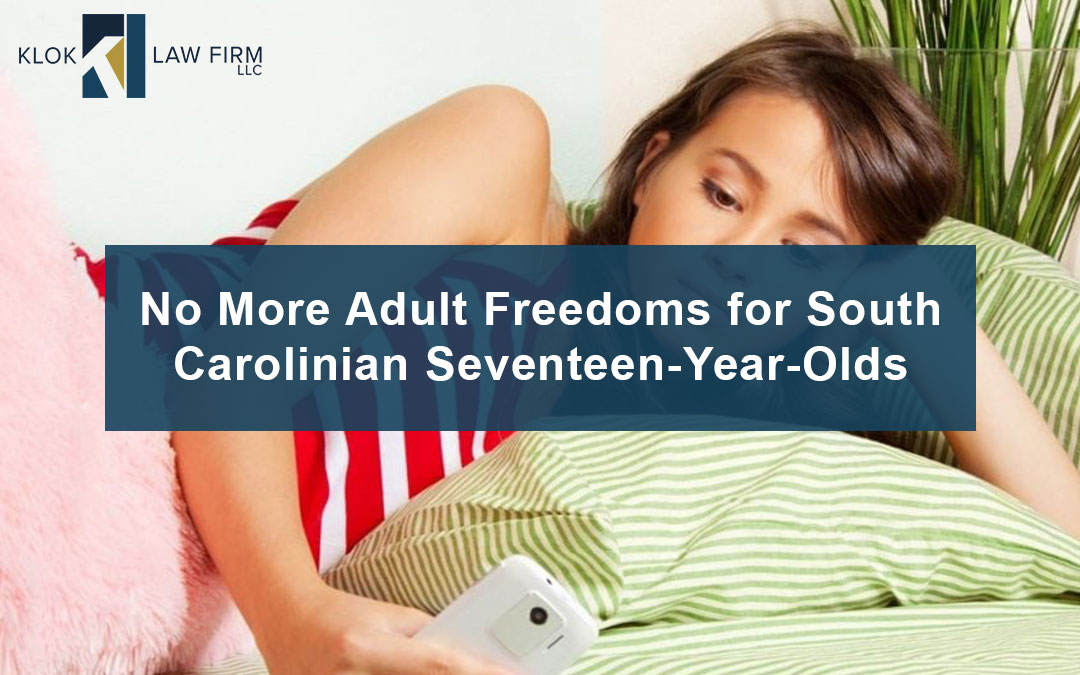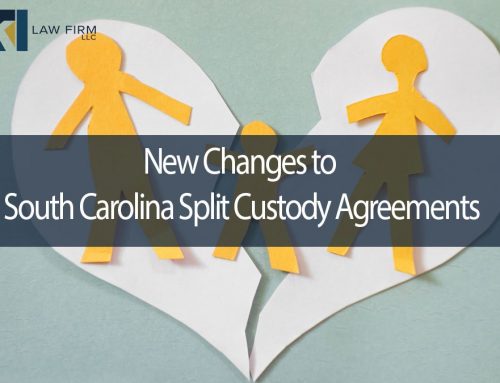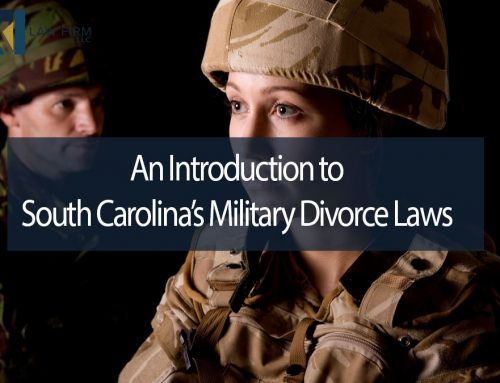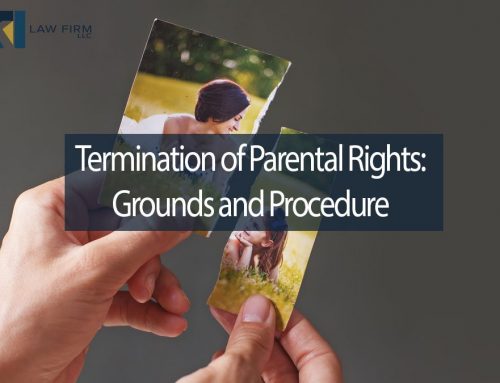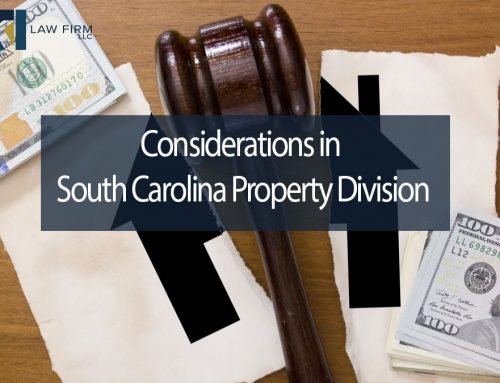No More Adult Freedoms for South Carolinian Seventeen-Year-Olds
A change to the laws of South Carolina took place with little fanfare; yet, this amendment of the law brings about a significant modification to the rights of teens in the State. South Carolinian seventeen-year-olds and those who care for them do well to become aware of this significant change and what the change in the law will mean for teenagers. For one, the change raises upward by a year the time at which a teen no longer needs face arrest for leaving the care and control of parents or guardians without permission.
In June 2016, the South Carolina Governor signed into law Senate Bill number 916, which amended section 63-19-20 of the 1976 Code of Laws of South Carolina, the statutory law of the State.[1] Although enacted in 2016, the amendment only took effect on July 1, 2019.[2]
And, the statutory change has far-reaching consequences that belie the simple change of wording in that section of the South Carolina Children’s Code. As summarized by the South Carolina State Senate Press Office, Senate Bill 916 “[c]hanges the juvenile justice code definition of child and juvenile from less than 17-years-old to less than 18-years-old.”[3] This seemingly minor change in a definition is expected to have great impact on South Carolinian youth and their families.
That the change in definition will have such impact is underscored by the expected financial cost of the amendment to the State. The anticipated cost to the State is millions of dollars a year, largely because of expected “increased youth population” that will generate greater operating costs of the Department of Juvenile Justice and will require more “intake and probation/parole staff to manage the increased youth population.”[4]
As a consequence of this change to the definition of child and juvenile, adult-like freedoms previously enjoyed by South Carolinian seventeen-year-olds will be taken from them, and those seventeen-year-olds will have to face the increased likelihood that they will be arrested, if only as a provisional remedy for the sake of the child’s best interests, health, safety and welfare. As noted in the South Carolina Incident Based Reporting System (“SCIBRS) Training Manual,[5]
Runaway – 90I (Not a Crime)
Definition – A person under 18 years of age who has willfully left home without the permission of his/her parent(s) or legal guardian.
While running away does not constitute a criminal offense, each “handling” or taking into custody of a runaway must be reported using the Group B arrestee segment. Detentions of runaways from one jurisdiction by another agency should be reported by the home jurisdiction.
If considered a minor, an adolescent “who has willfully left home without the permission of his/her parent(s) or legal guardian” may be adjudicated as a “runaway child,” and face legal issues based upon such a legal finding.[6]
Before the 2016 amendment, in the following terms, the Office of the South Carolina Attorney General discussed the statutory and common law authority regarding the responsibility of law enforcement to take a report from the parents of and return to home a seventeen-year-old runaway:[7]
As you may be aware, the responsibilities of law enforcement, parents, and state agencies with respect to seventeen-year-old causes some confusion. South Carolina law attempts to recognize that a seventeen-year-old is no longer a child but is not yet legally an adult.
* * *
In instances of a runaway in which the parents do not consent to the child’s departure from the home, the child would not be considered an emancipated minor under our case law. . . . Parents, therefore, are in some instances still legally responsible for their runaway seventeen-year-old.
* * *
We would advise that you take the report from the parents, enter the report in NCIC, and if the child is located, return the seventeen-year-old to home. Although the juvenile will be an adult soon enough, precaution mandates treating him as a child.
Clearly missing from the statements from the Office of the South Carolina Attorney General, prior to the 2016 amendment, was any indication that a seventeen-year-old youth runaway had committed a status offense, an act “considered unlawful only because of the age of the offender.”[8] Rather, the focus of the Office of the South Carolina Attorney General was on “the legal right to take into custody a seventeen-year-old when the child’s welfare, life, or physical safety is endangered.”[9]
However, with the 2016 amendment to the definition of child and juvenile, South Carolinian seventeen-year-olds must now face the prospect of arrest for being runaways, a status offense.
Nearly one-quarter of all incarcerated youth are not incarcerated for a crime that could be committed by an adult; rather, they were incarcerated for a status offense – because the conduct was deemed unlawful because of the age of the youth.[10] This fact regarding adolescent incarceration exists despite the reality that noncriminal offensive behaviors and misconduct is not unusual among adolescents, and can even be expected as an element of the normal development of children along their pathway to adulthood.[11]
Most “research has defined running away by reference to a child leaving home without permission and staying away some length of time.”[12] And, studies report that “a large number of American youth in their teenage years run away from home and other places.”[13] And it can be said,[14]
America could be called a nation of runaways with no exaggeration of the historical record. The settlement and expansion of this country was driven by people, many of them adolescents, running away from home and family, from slave masters and employers. Children and adults alike ran to America and within America to escape tyranny and oppression, to seek adventure, and to make their fortunes. Running away was an admired and venerable tradition in American culture. Folk heroes as diverse as Benjamin Franklin and Davy Crockett were runaways as was one of the most beloved of all America’s literary figures, Huck Finn.
While it can be argued that historically no provisions in the law specifically authorized a law enforcement officer to pick up even a child reported missing,[15] and that the criteria to take a juvenile into custody existed only where the juvenile committed a criminal offense, clearly the current trend is to take runaway adolescents into custody if they are not adults.[16]
Given research on the issue over the years, there is some reason to be concerned that runaway children need protection:[17]
When a child runs away, they are at significant risk of being in danger and being harmed. Even if the child voluntarily left home, immediate efforts must be implemented to find the child due to the peril they may face. Running away is among the most dangerous of undertakings a child commits because children often do not perceive themselves as potential victims. The dangers runaway children mainly face are sex trafficking, risks associated with homelessness, and being lured away to a dangerous situation over the Internet.
In the past, while the advice to an adolescent might have been that if the child was 17 years of age or older, the child could not be charged with a status offense as a runaway, or returned home, that advice is no longer sound as of July 1, 2019, given the change in the law in 2016. The police can and likely will arrest a child identified as a runaway – even if they are 17, subject the adolescent to the workings of the juvenile justice system, and require the adolescent to address the status offense and consequences of the same until they are 18 – or older.
[1] Leg. Hist. SB 916, Act 268 (2016) [available at: https://www.scstatehouse.gov/billsearch.php; Session 121, Bill Number 916].
[2] S.C. Code § 63-19-20.
[3] S.C. State Senate Press Office, This week in the Senate at 2 (May 23 – May 27, 2016)[available at: https://www.scstatehouse.gov/senatepage/ThisWeekInTheSenate/May%2023-27,%202016.pdf]. Also compare S.C. Code § 63-19-20 (2015) with S.C. Code § 63-19-20 (2019).
[4] S.C. Revenue and Fiscal Affairs Office, Statement of Estimated Fiscal Impact – Bill Number S. 916, Juvenile Justice Code Definitions (March 17, 2016)[available at: http://rfa.sc.gov/files/impact/S0916_0.pdf].
[5] S.C. Law Enforcement Division, South Carolina Incident Based Reporting System (“SCIBRS) Training Manual at 41 (Rev. 2014)[available at: http://www.sled.sc.gov/SCIBRSManual.aspx?MenuID=CrimeReporting].
[6] In Interest of Darlene C, 301 S.E.2d 136, 278 S.C. 664, passim (S.C. 1983).
[7] 2000-09-27 SC Atty Gen Letter to Lt Constance.
[8] Joan McCord, et al., Juvenile Crime, Juvenile Justice at 54 (2001).
[9] 2000-09-27 SC Atty Gen Letter to Lt Constance.
[10] Richard J. Bonnie and Emily P. Backes, Eds., The Promise of Adolescence: Realizing Opportunity for All Youth at 263 (2019).
[11] Id.
[12] David Finkelhor, Ph.D., Gerald Hotaling, Ph.D., and Andrea Sedlak, Ph.D., Missing, Abducted, Runaway, and Thrownaway Children in America at 98 (U.S. DOJ: May 1990).
[13] Id. at 131.
[14] Id. at 97.
[15] 1985-10-29 SC Atty Gen Opinion No 85-126.
[16] 2000-09-27 SC Atty Gen Letter to Lt Constance; S.C. Law Enforcement Division, South Carolina Incident Based Reporting System (“SCIBRS) Training Manual at 41 (Rev. 2014)[available at: http://www.sled.sc.gov/SCIBRSManual.aspx?MenuID=CrimeReporting].
[17] Shannon Lacey, Missing Child Or Runaway: The Life Altering Label and How to Eliminate the Stigma Surrounding It, 20 Rutgers Race & L. Rev. 147, at 156 (2019).

